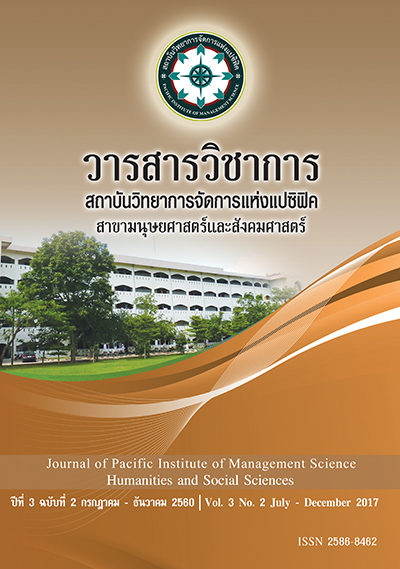Primary Educational Service Area Management under SakonNakhon Primary Educational Service Area Office
Keywords:
Primary Educational Service Area Management, Primary Educational Service Area OfficeAbstract
The research entitled, “Primary Educational Service Area Management under SakonNakhon Primary Educational Service Area Office,” aimed 1) to study the state of primary educational service area management under the SakonNakhon Primary Educational Service Area Office, 2) to create the model of primary educational service area management under SakonNakhon Primary Educational Service Area Office,and 3) to evaluate the model of primary educational service area management under SakonNakhon Primary Educational Service Area Office.
The samples used in the first period of this research were 245directors and personnel working forthe three offices of SakonNakhon Primary Educational Service Area. While in the second period of this research, the 9 informants were invited to participate in a focus group discussion. And in last period, the 20 experts were invited to be as the informants for evaluation.
The instruments used in this research were the questionnaire, focus group discussion, and the evaluation by the experts. In the quality test, the only items of questionnaire with above .50 value of the IOC were acceptable, and in the reliability test, Cronbach’s alpha value was rated at .98. The statistics used for quantitative data analysis in this research were percentage, mean, and standard deviation. In addition, the content analysis was employed for the qualitative data which were concluded from the experts’ suggestions.
The research findings revealed that
- The state of primary educational service area management under the SakonNakhon Primary Educational Service Area Officein the second standard, overall were at high level. Especially, the personnel management aspect was at the highest level; then, come to the policy drive to practiceaspect, and the lowest level was the budget management aspect.
- The model of primary educational service area management under SakonNakhon Primary Educational Service Area Office consisted of 6aspects, namely, 1) the model objectives, 2) the model principles, 3) operating mechanism, 4) operation, 5) evaluation, and success condition.
- The results of evaluation for the model of primary educational service area management under SakonNakhon Primary Educational Service Area Officeoverall, the implementation appropriateness, were at the highest level, and the implementation possibility were at high level, while each aspect was found that the model principles aspect was at the highest level, then come to the evaluation aspect. On the contrary, the aspects that had the lowest level of implementation appropriateness were model objectives aspect. While the implementation possibility was the model principles aspect, then come to the operation aspect, and the lowest level of implementation possibility belonged to the evaluation aspect.
References
ประกาศกระทรวงศึกษาธิการ เรื่องการแบ่งส่วนราชการภายในสำนักงานเขตพื้นที่การศึกษาประถมศึกษา พ.ศ. 2553. (2548, 19 กันยายน). ราชกิจจานุเบกษา. เล่ม 122 (ตอนที่ 90 ง), หน้า 9-11.
เลขาธิการสภาการศึกษา, สำนักงาน. (2549). รายงานการติดตามและประเมินความก้าวหน้าการปฏิรูปการศึกษา ด้านการเรียนรู้. กรุงเทพฯ: เซ็นซูรี่.
ดำรงค์ พวงอินทร์. (2549). คุณลักษณะที่พึงประสงค์ของผู้อำนวยการเขตพื้นที่การศึกษาตามความคิดเห็นของข้าราชการ ครูจังหวัดอุบลราชธานี. ปริญญาครุศาสตรมหาบัณฑิต สาขาการบริหารการศึกษา บัณฑิตวิทยาลัย มหาวิทยาลัย ราชภัฏอุบลราชธานี.
นภกมล ใจชอบสันเทียะ. (2555). รูปแบบการพัฒนาการปฏิบัติงานของผู้อำนวยการสำนักงานเขตพื้นที่การศึกษา. วิทยานพินธด์ษุฎบีณัฑติ. สาขาวิชาบริหารการศึกษา ภาควิชานโยบายการจัดการและความเป็นผู้นำทางการศึกษา คณะครุศาสตร์ จุฬาลงกรณ์มหาวิทยาลัย.
ญาณศิา บุญจิตร.์ (2552). การวิเคราะห์ปัจจัยที่ส่งผลต่อประสิทธิผลองค์การของสำนักงานเขตพื้นที่การศึกษา. วิทยานิพนธ์ ดุษฎีบัณฑิต. สาขาวิชาบริหารการศึกษา ภาควิชานโยบายการจัดการและความเป็นผู้นำทางการศึกษา คณะครุศาสตร์ จุฬาลงกรณ์มหาวิทยาลัย.
Downloads
Published
Issue
Section
License
บทความที่ได้รับการตีพิมพ์เป็นลิขสิทธิ์ของ สถาบันวิทยาการจัดการแห่งแปซิฟิค
ข้อความที่ปรากฏในบทความแต่ละเรื่องในวารสารวิชาการเล่มนี้เป็นความคิดเห็นส่วนตัวของผู้เขียนแต่ละท่านไม่เกี่ยวข้องกับสถาบันวิทยาการจัดการแห่งแปซิฟิค และคณาจารย์ท่านอื่นๆในสถาบันฯ แต่อย่างใด ความรับผิดชอบองค์ประกอบทั้งหมดของบทความแต่ละเรื่องเป็นของผู้เขียนแต่ละท่าน หากมีความผิดพลาดใดๆ ผู้เขียนแต่ละท่านจะรับผิดชอบบทความของตนเองแต่ผู้เดียว







